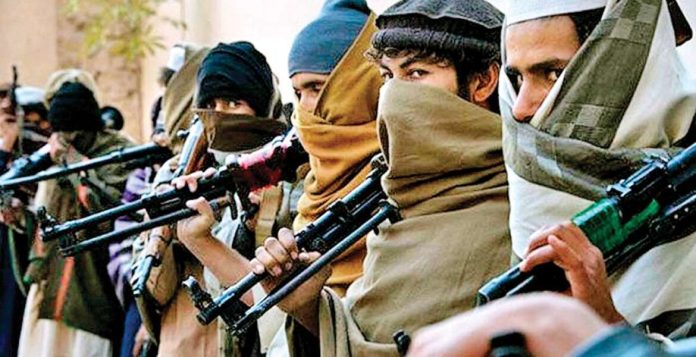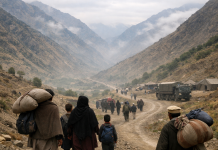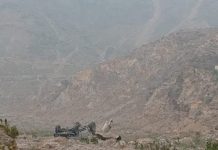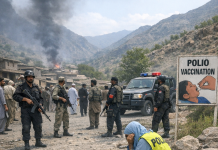By Ashrafuddin Pirzada
In the past two weeks, Khyber Pakhtunkhwa (KP) has witnessed a surge in terrorist incidents, leading to significant casualties among security personnel and civilians. The region, long plagued by militancy, has once again become a battleground between extremist elements and state forces.
A Wave of Deadly Attacks
The violence began on February 28, 2025, when a suicide bombing targeted Darul Uloom Haqqania seminary in Nowshera, a historic religious institution. The attack resulted in the deaths of six people, including Maulana Hamidul Haq Haqqani, the head of the seminary and a key leader of Jamiat Ulema-e-Islam-Sami (JUI-S). The bombing was a direct assault on one of the most influential religious figures in the country, raising fears of further sectarian and ideological conflict.
Two weeks later, on March 12, 2025, militants executed a well-coordinated attack, hijacking the Jaffar Express train travelling from Quetta to Peshawar. The brazen assault led to a deadly standoff, leaving 25 people dead, including 21 civilians and four security personnel.
The attack was one of the deadliest on public transport in Pakistan’s recent history, exposing the vulnerabilities in national security.
Security Forces Respond with Counter-Terrorism Operations
Determined to curb the growing threats, security forces launched multiple operations in various parts of the province. On March 15, 2025, counter-terrorism units stormed militant hideouts in Mohmand and Dera Ismail Khan districts, engaging in fierce clashes with suspected Pakistani Taliban (TTP) operatives. The encounter resulted in the deaths of nine militants and two soldiers.
A day later, on March 16, 2025, militants retaliated with a suicide bombing targeting a security forces’ post in Mir Ali, North Waziristan. The explosion caused severe damage and led to the martyrdom of seven soldiers, including two officers. This attack underscored the continued presence and operational capability of militant factions in the tribal districts.
Security forces swiftly responded on March 17, 2025, conducting an intelligence-based operation in Madikhel, North Waziristan. During this offensive, at least seven militants involved in the Mir Ali attack were killed. Despite these countermeasures, the cycle of violence in KP remains unbroken, highlighting the persistent security challenges in the region.
Mufti Munir Shakir: The Radical Cleric Who Sparked a Militant Era
Amid this wave of violence, another significant event unfolded—the death of Mufti Munir Shakir, a radical cleric whose militant ideology played a crucial role in shaping the security landscape of Khyber District.
On March 15, 2025, a powerful improvised explosive device (IED) blast in the Urmarr locality of Peshawar critically injured Mufti Shakir. He was rushed to Lady Reading Hospital, where he succumbed to his injuries. His violent death marked the closing of a bloody chapter in the history of the Khyber district, a region deeply affected by his extremist influence.
Mufti Munir Shakir, a hardline Deobandi cleric, first gained notoriety in the early 2000s when he arrived in Bara, Khyber District. He initially aligned with Haji Namdar, the leader of a strict Islamic enforcement group, but their ideological differences led to a bitter conflict. Using an illegal FM radio station, Shakir spread his hardline ideology, recruiting followers and inciting violence.
2004, he was expelled from Bara due to growing tensions with local tribal elders. However, his expulsion did not end his ambitions. He rebranded his group as Lashkar-e-Islam (LI), drawing support from the Sipah and Malikdinkhel tribes. His movement quickly became embroiled in a violent power struggle with Pir Saifur Rehman, a Barelvi cleric with his following in Khyber. The rivalry escalated into an armed tribal conflict in 2005, prompting local elders to intervene and force both leaders to leave the region.
The Rise of Lashkar-e-Islam Under Mangal Bagh
With Shakir sidelined, Mangal Bagh, a former bus driver turned militant commander, took control of Lashkar-e-Islam. Under his leadership, the group implemented a reign of terror in Khyber, enforcing strict social codes, banning music and movies, collecting extortion, and attacking security forces.
Pakistan’s security forces launched multiple operations against LI, pushing them into the Tirah Valley. However, despite military action and the government’s official ban on the group in 2008, Lashkar-e-Islam continued to operate, carrying out sporadic attacks for over a decade. Mangal Bagh remained at the helm until he died in a 2021 drone strike in Afghanistan.
A Militant’s End and Unanswered Questions
Although Mufti Munir Shakir had been out of the militant spotlight for years, his past never let him escape. He had been running Jamia Masjid Nida-e-Quran in Urmarr, Peshawar, where he continued his religious activities. But on March 15, 2025, his past caught up with him.
The IED attack that killed him remains shrouded in mystery. No group immediately claimed responsibility. Some speculated that it was a revenge killing by victims of Lashkar-e-Islam’s brutal rule, while others pointed to disputes within militant circles.
Barrister Dr. Muhammad Ali Saif, the KP government spokesperson, condemned the attack, stating, “Attacks on religious scholars are extremely concerning and condemnable. The killers of innocent people are enemies of humanity.”
However, for many in Khyber, Mufti Shakir’s death was poetic justice—the culmination of a life spent fueling militancy, radicalism and bloodshed.
The Ongoing Battle Against Extremism
While Mufti Shakir’s death marks the end of one militant era, the broader struggle against extremism in Khyber Pakhtunkhwa is far from over. The recent attacks in Nowshera, North Waziristan, Peshawar, Mohmand and Dera Ismail Khan are stark reminders that militant networks continue to operate with impunity.
The Jaffar Express hijacking and suicide bombings signal that groups like the TTP and their affiliates remain a serious threat, capable of launching large-scale assaults. Despite military operations, security forces are facing a resilient and adaptive enemy.
With security forces on high alert, the region remains under watch, with authorities determined to prevent another militant leader from rising from the ashes of Lashkar-e-Islam and other banned militant groups.
Today, a school bus carrying Army Public School children was targeted with a suicide bomber in Khusdar locality in Balochistan, killing 4 innocent and injuring more than 30. Reports suggest that the number of deaths could be high, and most of them are seriously injured. So, the question is that in Pakistan, especially in Balochistan, Khyber Pakhtunkhwa and merged districts, the situation is gradually getting worse due to militants’ attacks on not only law enforcement forces but also targeting journalists, civil society members, school children and even children in homes. Recently, a viral video showed that militants had entered a state-run school in Waziristan and threatened school staff and children to close the school and avoid coming to the school again. So, the decades-long militancy and unrest on the Pashtun soil claimed thousands of innocent lives so far and would be unfortunately worse for them in the coming months.











